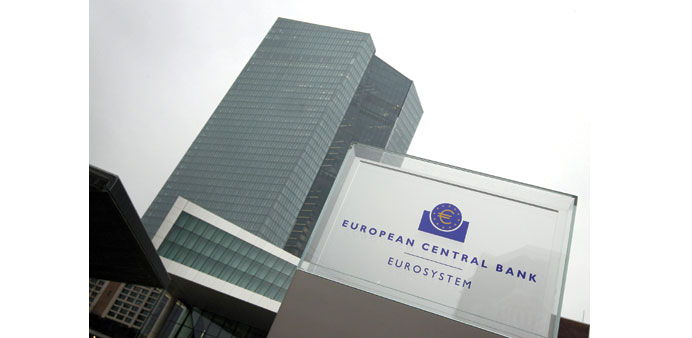The new headquarters of the European Central Bank in Frankfurt. The final countdown is under way for the ECB’s programme of government-bond purchases, which already fuelled a debt-market rally that sent yields across the euro region to record lows.
Bloomberg
London
The final countdown is under way for the European Central Bank’s programme of government-bond purchases, which already fuelled a debt-market rally that sent yields across the euro region to record lows.
The ECB will start its €1.1tn ($1.2tn) quantitative-easing plan tomorrow, President Mario Draghi said in Cyprus last week. The purchases, which are to include public and private debt, will be conducted in the secondary market by national central banks via existing counterparties.
Draghi spurred demand for higher-yielding bonds on Thursday, when he said securities won’t be purchased if their yields are below the ECB’s deposit rate of minus 0.2%.
“What markets will key in on most is exactly what kind of rhyme or reason are we able to sort out from their buying patterns,” said Richard Kelly, head of global strategy at Toronto Dominion Bank in London. “The early flow will be parsed to see if they are concentrating in any particular area of the curve and if it looks coordinated and correlated across countries or not.”
Yields have plunged on concern the plan may lead to a scarcity of fixed-income assets. Eighty-four of the 346 securities in the Bloomberg Eurozone Sovereign Bond Index have rates below zero, data compiled by Bloomberg showed on Friday, meaning buyers would get less back when the debt matures than they paid to buy them. That includes all German government bonds due in six years or less.
“We see optimistic sellers at the start of the program,” said Christoph Rieger, head of fixed-rate strategy at Commerzbank in Frankfurt. “Accounts who have bought in advance of the ECB purchases will sell and thus it may initially look like they can achieve their volumes quite smoothly until the scarcity” concerns emerge, he said.
Only securities due between a minimum two years and a maximum 30 years and 364 days at the time of purchase will be eligible, and there are other limits on how many bonds can be bought to reach the target of €60bn a month.The trading desks of the euro-area’s national central banks do have some discretion over what they buy and when, the ECB said in a March 5 document.
Italy’s 10-year yield fell one basis points, or 0.01 percentage point, in the week to 1.32% at the 5 pm London close on Friday. It touched 1.259%, the least since Bloomberg began collecting the data in 1993.
The price of the 2.5% Italian bond due in December 2024 rose 0.115, or €1.15 per €1,000 face amount, to €110.81.
German two-year notes missed out on the gains after Draghi effectively set a minimum rate of minus 0.2% for ECB purchases. Yields on the securities climbed to a four-week high of minus 0.184% on Thursday before ending the week at minus 0.207%. They rose for the first week since December 5.
Speculation over the form the quantitative-easing programme will take has dominated trading of euro-area bonds since it was announced in January. The first clues as to how it will work in practice will emerge on Monday.
“As a rule we’d expect the lines least easy to source to benefit more than benchmark issues that are still being tapped,” Ciaran O’Hagan, head of European rates strategy at Societe Generale in Paris, wrote in an e-mailed note. The central banks “will be wary of not creating large price distortions.”



